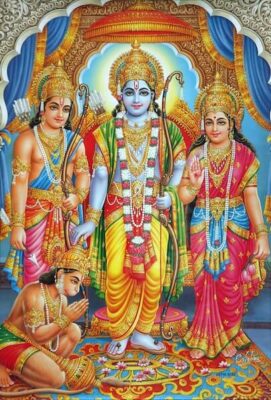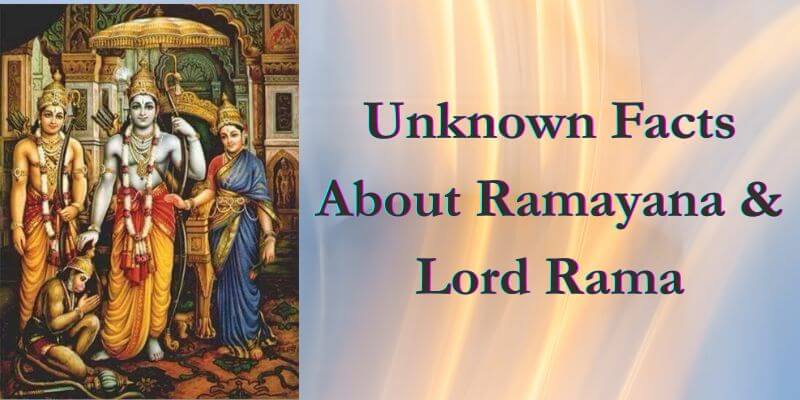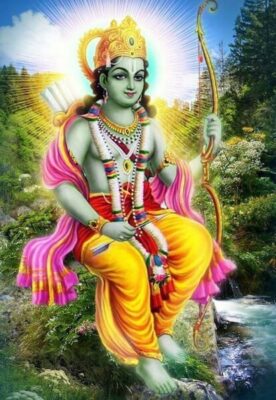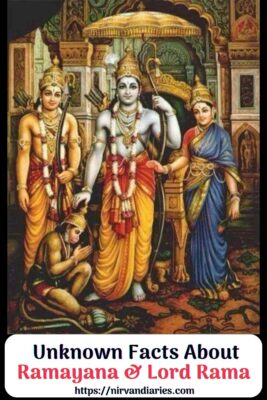Hinduism, one of the world’s oldest religions, is rich with a vast array of scriptures and epics that have shaped its cultural and spiritual landscape.Among these, the “Ramayana” and the “Mahabharata” stand out as monumental narratives that encapsulate profound moral and philosophical teachings.
While the “Mahabharata” delves into the complexities of duty and righteousness through the Kurukshetra war, the “Ramayana” narrates the life and virtues of Lord Rama, exemplifying the ideals of dharma (righteousness). This article aims to unveil some of the amazing secrets hidden in the “Ramayana” that you might not be aware of, shedding light on its lesser-known facets and the timeless lessons it imparts.
Table of Contents
The Ramayana

The “Ramayana” is an ancient Indian epic that narrates the life and adventures of Lord Rama, the seventh incarnation of Lord Vishnu. Composed by the sage Valmiki, it consists of 24,000 verses divided into seven Kandas (books), detailing Rama’s journey from his birth to his coronation as the king of Ayodhya.
The epic begins with the joyous occasion of Rama’s birth in the kingdom of Ayodhya, to King Dasharatha and Queen Kaushalya. As Rama grows, he embodies virtues of righteousness, compassion, and valor, making him the ideal prince and heir to the throne. His unwavering adherence to dharma is evident when he willingly accepts a fourteen-year exile to honor his father’s promise, showcasing his commitment to righteousness over personal comfort.
During his exile, Rama’s wife, Sita, is abducted by the demon king Ravana, leading to an epic quest to rescue her. With the assistance of his loyal brother Lakshmana and the devoted Hanuman, Rama forms alliances with various beings, including the Vanara (monkey) king Sugriva and his army. The construction of the Ram Setu, a bridge connecting India to Lanka, stands as a testament to their collective effort and determination.
The ensuing battle culminates in Rama’s victory over Ravana, symbolizing the triumph of good over evil. Upon returning to Ayodhya, Rama’s reign, known as “Rama Rajya,” is marked by peace, prosperity, and justice, setting an ideal for governance and societal harmony. The “Ramayana” not only narrates a captivating story but also imparts profound moral and ethical lessons, making it a timeless guide for humanity.
Life Lessons From Ramayana
Lord Rama, often referred to as “Maryada Purushottam,” epitomizes the pinnacle of virtue and righteousness. His life serves as a blueprint for ethical living and upholding one’s duties. One of the most notable instances of his unwavering commitment to dharma is his acceptance of exile to honor his father’s word, encapsulated in the saying “Pran jaye par vachan na jaye” (One may lose their life but should not break a promise).
This act underscores the importance of keeping promises and respecting one’s elders, even at great personal cost. Rama’s relationship with his brothers, especially his bond with Lakshmana and Bharata, highlights the values of familial love, loyalty, and selflessness. Despite being the rightful heir, Rama steps aside for Bharata without resentment, emphasizing humility and detachment from power. His unwavering love and respect for Sita, even in the face of adversity, showcase the ideals of marital fidelity and mutual respect.
Rama’s leadership during the battle against Ravana demonstrates strategic acumen, courage, and the importance of standing against injustice. His fair treatment of allies and even former enemies reflects his magnanimity and sense of justice. The “Ramayana” teaches that true leadership is rooted in selflessness, integrity, and a commitment to the greater good. Rama’s life encourages individuals to prioritize duty over personal desires, uphold moral values, and lead with compassion and fairness. These timeless lessons continue to resonate, offering guidance on leading a life of virtue and purpose.
20 Unknown Facts About Ramayana | Interesting Facts About Ramayana | Secrets Of Ramayana

The Ramayana is one of the greatest epics of all time, a timeless tale of dharma, devotion, and divine intervention. While most of us are familiar with the core story of Lord Rama, Devi Sita, and Ravana, there are many lesser known facts about Ramayana that make this epic even more intriguing. The ancient scripture, composed by Maharishi Valmiki, holds secrets that have been passed down through generations.
The “Ramayana” is replete with intriguing details that often escape common knowledge. Here, we present some unknown facts about Ramayana that will deepen your understanding of this sacred text and its significance.
1. The Ramayana Has Different Versions Across Asia
The Ramayana is not confined to India alone; various versions exist in countries such as Thailand, Indonesia, Cambodia, and Nepal. The Thai version, known as Ramakien, portrays Hanuman as a ladies’ man, which is quite different from the celibate Hanuman in the Indian tradition. The Cambodian Reamker emphasizes Ravana’s nobility, while the Javanese Kakawin Ramayana introduces new episodes. These versions reflect local cultures and beliefs, demonstrating the universality of Lord Rama’s story.
2. Valmiki Was Once a Robber
Maharishi Valmiki, the sage who composed the Ramayana, was initially a ruthless bandit named Ratnakara. He would rob and kill people to sustain his family. However, after meeting the great sage Narada, he realized the futility of his actions and meditated for years. It is said that an anthill formed around him due to his deep meditation, giving him the name Valmiki (which means ‘born of an anthill’).
3. Sita Was Not Born from the Earth
Although Sita is often described as being found in a furrow while King Janaka was plowing the fields, certain texts suggest she was an incarnation of Vedavati. Vedavati had cursed Ravana that she would be born as the cause of his destruction. Thus, Sita’s divine origin was tied to Ravana’s downfall from the very beginning.
4. Ravana Was a Devotee of Lord Shiva
Despite being the antagonist in the Ramayana, Ravana was an ardent devotee of Lord Shiva. He composed the Shiva Tandava Stotram, a powerful hymn in praise of Shiva. Legend says he once lifted Mount Kailash to showcase his might, but Shiva humbled him by pressing it down with his toe, leaving Ravana trapped until he repented.
5. Lakshmana Did Not Sleep for 14 Years
Lakshmana took a vow that he would not sleep for the entire duration of Lord Rama’s exile. Goddess Nidra, the deity of sleep, granted his request, and in return, his wife Urmila slept continuously for 14 years so that her husband could stay awake and protect Rama and Sita.
6. Hanuman Once Rejected Sita’s Gift
After the battle, Sita gave Hanuman a beautiful pearl necklace as a token of appreciation. However, Hanuman rejected it, saying he valued only those things that contained Rama’s name. To prove his devotion, he tore open his chest, revealing Lord Rama’s name inscribed in his heart.
7. Ravana Knew He Would Be Defeated
Ravana, despite his arrogance, was aware that he would be killed by Lord Rama. He had received a boon from Brahma that he could not be killed by gods, demons, or celestial beings. However, he underestimated humans, which led to his downfall when Vishnu incarnated as Rama.
8. The Bridge to Lanka Still Exists
The Ram Setu, believed to be built by Lord Rama’s army to cross to Lanka, can still be seen between India and Sri Lanka. A NASA satellite image revealed a chain of limestone shoals in the region, sparking debates about whether it is indeed the remains of the ancient bridge described in the Ramayana. The bridge built by Rama’s army to reach Lanka, known as Ram Setu or Adam’s Bridge, has been a subject of scientific and archaeological interest, with studies exploring its origins and structure.
9. Kumbhakarna Was Cursed to Sleep
Ravana’s brother Kumbhakarna was incredibly powerful but had a peculiar condition—he would sleep for six months at a stretch and stay awake for just one day. This was due to a curse from the gods, who feared his strength and manipulated a mispronunciation of his request for a boon.
10. The Squirrel’s Contribution to the Bridge
A small squirrel played a vital role in building the bridge to Lanka by rolling in the sand and shaking it off onto the structure. Lord Rama, moved by its devotion, blessed it by gently stroking its back, leaving behind the three stripes seen on squirrels today.
11. Hanuman’s Tail Could Grow Infinitely
Hanuman had the ability to change his size at will, and his tail played a crucial role in Lanka. When Ravana ordered it to be set on fire, Hanuman used this as an opportunity to burn down Lanka, showcasing his strategic brilliance.
12. Rama’s Army Included Animals Beyond Monkeys
Though vanaras (monkey warriors) are most famous in the Ramayana, Rama’s army also included bears and other creatures. The great bear Jambavan was one of his most trusted allies.
13. Luv and Kush Defeated Lord Rama’s Army
Rama’s sons, Luv and Kush, unknowingly captured the Ashwamedha horse, leading to a battle with their father’s forces. They single-handedly defeated warriors like Lakshmana and Hanuman, proving their divine lineage.
14. The Ramayana Contains a Prediction of Kali Yuga
It is believed that the Ramayana alludes to the eventual decline of dharma and the rise of corruption in the Kali Yuga, the current era of darkness and ignorance.
15. Hanuman Is Considered Immortal
Hanuman is said to be a Chiranjeevi, an immortal being who continues to exist. Many devotees believe he still roams the earth, especially in places where Lord Rama is worshipped.
16. Lord Rama Had an Elder Sister
Shanta, the elder sister of Rama, is not commonly mentioned in popular retellings. She was adopted by King Romapada of Anga and played a significant role in certain regional versions of the Ramayana.
17. The Real Reason for Sita’s Agni Pariksha
Sita’s trial by fire was not just to prove her purity but also to return her original divine form, as she had been replaced by an illusionary Sita during her stay in Lanka.
18. The Bow of Lord Shiva Could Not Be Lifted by Anyone But Rama
During Sita’s swayamvara, numerous kings tried to lift Lord Shiva’s bow, but only Rama succeeded, showcasing his divine strength.
19. Ravana Had a Chariot That Could Fly
Ravana’s Pushpaka Vimana was a flying chariot that could travel at incredible speeds, demonstrating advanced knowledge of aerodynamics.
20. The Ramayana Ends Differently in Some Versions
Some versions of the Ramayana do not end with Sita’s return to Ayodhya. The Uttara Kanda describes how she returns to Mother Earth, while Jain and Buddhist versions provide alternate conclusions.
21. Rama’s Birth Alignment with Gayatri Mantra: The original “Ramayana” comprises 24,000 verses, and it’s believed that the first letter of every 1,000 verses forms the Gayatri Mantra, symbolizing the essence of the epic.
22. Duration of Rama’s Reign: According to the epic, after returning from exile and defeating Ravana, Lord Rama ruled Ayodhya for 11,000 years, ushering in an era of peace and prosperity.
23. Kaushalya’s Counsel to Rama: Before Rama embarked on his exile, his mother, Kaushalya, imparted wisdom and blessings, emphasizing the importance of righteousness and patience during challenging times.
24. Valmiki’s Encounter with Rama: Sage Valmiki, the author of the “Ramayana,” is believed to have met Rama during his exile, adding authenticity and depth to his narration.
These fascinating facts about the Ramayana highlight the depth and richness of this timeless epic. What are your thoughts on these lesser-known aspects of the story?
20 Lesser Known Facts About Lord Rama

Lord Rama, the seventh avatar of Lord Vishnu, is revered for his virtues, discipline, and adherence to dharma. While many are familiar with the broad storyline of the Ramayana, there are several intriguing aspects of his life that remain lesser known. His story goes beyond the battle with Ravana and provides deep spiritual and moral lessons. We bring to you here lesser known facts about Lord Rama.
- Lord Rama’s Birth Was a Divine Plan
Unlike ordinary births, Rama’s birth was a divine event orchestrated by the gods. Lord Vishnu took human form to rid the world of Ravana, who had obtained a boon making him invincible to gods but not to humans. His birth was the fulfillment of a celestial prophecy to restore dharma on Earth. - Rama’s Name Holds Profound Power
The name “Rama” is considered one of the most powerful mantras in Hinduism. The mere chanting of his name is believed to absolve sins and bring peace and enlightenment. Saints like Tulsidas and Goswami Valmiki emphasized the power of “Rama Naam” in their spiritual teachings. - Rama Was a Master of All Weapons
Though known for his devotion to dharma, Rama was an unparalleled warrior. He mastered celestial weapons such as the Brahmastra, Vaishnavastra, and the divine bow of Lord Shiva, making him invincible in battle. - Rama’s Exile Was Not a Punishment but a Cosmic Test
Many believe that Rama’s exile was a consequence of Kaikeyi’s demand, but it was, in fact, a divine test of his character. By accepting exile gracefully, he set an example of patience, obedience, and unwavering faith in dharma. - Lord Rama Respected His Enemies
Rama did not bear hatred even towards his greatest enemy, Ravana. Before the final battle, he sent Ravana a message urging him to seek forgiveness and abandon his evil ways. Even after slaying Ravana, Rama instructed Lakshmana to learn wisdom from the dying demon king. - Rama’s Connection with Lord Shiva
Rama was an ardent devotee of Lord Shiva. Before attacking Lanka, he worshipped Shiva at Rameswaram, seeking his blessings. The Rameswaram temple stands as a testimony to his devotion to Lord Shiva. - Rama’s Reign Was Known as “Rama Rajya”
Under Lord Rama’s rule, Ayodhya flourished with peace, justice, and prosperity. “Rama Rajya” symbolizes an ideal society where righteousness prevails, and citizens live harmoniously. - Rama’s Role in Mahabharata
Though the Ramayana predates the Mahabharata, Lord Rama is subtly mentioned in the later epic. Krishna, an incarnation of Vishnu, refers to Rama’s righteous rule as an ideal for kings to follow. - Lord Rama Did Not Know He Was an Incarnation of Vishnu Initially
Though an incarnation of Vishnu, Rama lived as a human and followed all mortal limitations. It was only later, when reminded by sages and celestial beings, that he recognized his divine mission. - The End of Rama’s Earthly Life
After ruling Ayodhya for several years, Lord Rama walked into the Sarayu River, ending his earthly journey. It is believed that he merged back into Lord Vishnu’s divine form, marking the end of his avatar. - Lord Rama Had an Elder Sister
While most people are familiar with Rama’s three brothers—Lakshmana, Bharata, and Shatrughna—few know that he also had an elder sister named Shanta. She was the daughter of King Dasharatha and Queen Kausalya but was later adopted by King Romapada of Anga. Shanta was married to Sage Rishyashringa, whose penance brought rains to the drought-stricken kingdom of Anga. - Lord Rama’s True Age During Exile
Many believe that Lord Rama was a young man when he was exiled, but according to some scriptures, he was around 25 years old. The exile lasted for 14 years, meaning he returned to Ayodhya when he was nearly 40 years old. - Lord Rama Never Slept for 14 Years
During his exile, Lord Rama was deeply committed to protecting Sita and maintaining his dharma. It is said that he never slept during those 14 years, as he was constantly vigilant. Lakshmana also followed suit and remained awake with the help of Nidra Devi’s blessing. - Lord Rama Had a Curse That Made Him Suffer Separation from Sita
In one of his previous incarnations as Lord Vishnu, he playfully drenched his consort, Goddess Lakshmi, in water. In response, she playfully cursed him that he would experience the pain of separation from his beloved in one of his earthly incarnations. This curse manifested in his life as Lord Rama when he was separated from Sita during her abduction and later during her banishment. - The Secret Behind Lord Rama’s Blue Skin
Lord Rama is often depicted with blue skin, which symbolizes his divine nature. The blue complexion is associated with the infinite sky and ocean, representing vastness, tranquility, and the cosmic nature of his existence. Some texts also suggest that his skin had a bluish tint due to the power of his divine energy. - Lord Rama Had an Unmatched Warrior Streak
Although Lord Rama is known for his righteousness and patience, he was also a fierce warrior. In addition to his battle against Ravana, he single-handedly defeated 14,000 asuras led by Khara and Dushana in Janasthana. His archery skills were unmatched, and he could release multiple arrows simultaneously with unerring precision. - Lord Rama Once Killed Thousands of Sea Demons
Before building the Ram Setu bridge to Lanka, Lord Rama requested permission from the Sea God to allow his army to pass. When the Sea God did not respond, Rama shot powerful arrows into the ocean, which destroyed thousands of sea demons. This act forced the Sea God to appear and humbly assist in constructing the bridge. - Lord Rama’s Connection to the Solar Dynasty
Lord Rama belonged to the Ikshvaku dynasty, also known as the Suryavansha (Solar Dynasty). His lineage traced back to King Ikshvaku, the son of Lord Surya (the Sun God). This divine connection symbolized his role as a beacon of dharma and righteousness. - The Lesser-Known Story of Rama’s Ring
A lesser-known folktale states that once, a small ring belonging to Lord Rama fell into a hole in the ground. Hanuman was sent to retrieve it and descended deep into the earth, only to find a heap of similar rings. This mystical event was said to symbolize the infinite cycles of Ramayana occurring in different cosmic eras. - Lord Rama’s Name is One of the Most Powerful Mantras
The name ‘Rama’ is considered one of the most powerful and auspicious mantras. Saints and devotees have chanted ‘Rama’ for centuries, believing that it grants peace, spiritual enlightenment, and liberation. It is said that even Lord Shiva chants the name of Rama in deep meditation.
These lesser-known facts about Lord Rama enrich our understanding of his divine character, inspiring devotion and reverence among his followers.
Unknown Facts About Ramayana | Lesser Known Facts About Lord Rama – FAQs | Frequently Asked Questions (FAQs) About the Ramayana and Lord Rama
The Ramayana is one of the greatest epics of Hindu mythology, narrating the divine journey of Lord Rama, his exile, and his battle against the demon king Ravana. While many are familiar with the major events of the Ramayana, there exist numerous lesser-known facts and intriguing details that add depth to this sacred tale.
-
Who wrote the Ramayana?
The Ramayana was originally composed by the sage Valmiki in Sanskrit. It is considered one of the greatest Hindu epics and is divided into seven Kandas (books), narrating the life and journey of Lord Rama. -
What does the name ‘Ramayana’ mean?
The word ‘Ramayana’ is derived from two Sanskrit words: ‘Rama’ (the protagonist) and ‘Ayana’ (journey or path). Hence, the Ramayana translates to “The Journey of Rama.” -
Was Lord Rama a historical figure or a mythological one?
Many scholars and believers consider Lord Rama a historical figure, with references to his existence found in ancient scriptures and folklore. Some even attempt to correlate his timeline with astronomical and archaeological findings. -
What is the significance of Lord Rama’s bow?
Lord Rama’s bow, known as ‘Sharanga,’ was gifted by Lord Vishnu. It was so powerful that only Rama could string and lift it, as demonstrated in the Swayamvara of Sita. -
Why did Lord Rama go into exile?
Lord Rama was sent into a 14-year exile due to a promise that his father, King Dasharatha, had made to Queen Kaikeyi. She demanded that her son Bharata be crowned as king and Rama be exiled to the forest. -
Was Lord Rama aware that he was an incarnation of Lord Vishnu?
Initially, Lord Rama lived as an ideal human, unaware of his divine nature. However, as events unfolded, sages and deities reminded him of his divine purpose. -
Why did Ravana kidnap Sita?
Ravana kidnapped Sita to avenge his sister, Shurpanakha, whose nose was cut off by Lakshmana when she tried to harm Sita. Additionally, he was destined to be defeated by Lord Vishnu’s incarnation. -
What was the role of Hanuman in the Ramayana?
Hanuman played a crucial role as the greatest devotee of Lord Rama. He helped locate Sita, burned Lanka, and fought valiantly in the battle against Ravana. -
Why did Lord Rama test Sita’s purity?
After rescuing Sita, Lord Rama wanted to ensure her chastity and uphold dharma. She underwent the Agni Pariksha (trial by fire) to prove her purity. -
Who were Lava and Kusha?
Lava and Kusha were the twin sons of Lord Rama and Sita, born in Sage Valmiki’s ashram. They later recited the Ramayana to their father without knowing his true identity. -
Did Lord Rama ever meet Lord Hanuman again after the Ramayana?
It is believed that Hanuman continued to serve Lord Rama even after the events of the Ramayana and remains immortal to this day. -
What happened to Ravana’s kingdom after his defeat?
After Ravana’s defeat, Lord Rama installed Ravana’s righteous brother, Vibhishana, as the new king of Lanka. -
Why did Lord Rama leave the Earth?
After fulfilling his purpose, Lord Rama ended his mortal journey by entering the Sarayu River, returning to his divine abode, Vaikuntha. -
Are there different versions of the Ramayana?
Yes, apart from Valmiki’s Ramayana, different versions exist, including Tulsidas’ Ramcharitmanas, Kamban’s Tamil Ramayana, and other regional adaptations. -
What is the spiritual significance of the Ramayana?
The Ramayana teaches righteousness (dharma), devotion (bhakti), and the ideal way of life. It serves as a guide for moral and ethical values.
The Ramayana is not just an epic; it is a timeless guide filled with wisdom, devotion, and lessons for life. We hope you liked this post about unknown facts about Ramayana and lesser known facts about Lord Rama– the secrets of Ramayana. What are your thoughts after reading this post about the interesting facts about Ramayana? Please let us know in the comments section. Also, please share this post about unknown facts about Ramayana and lesser known facts about Lord Rama – the secrets of Ramayana with your family, friends, on WhatsApp, and on social media.

Thanks for visiting our site nirvandiaries.com and taking the time to read this post.
If you wish to collaborate or work with us, then reach us at [email protected]
We’d love it if you’d comment by sharing your thoughts on this post and share this post on social media and with your friends.
Follow our journey on our social media channels:
X Instagram Pinterest






